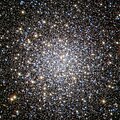| Messier 5 | |
|---|---|
 Globular cluster Messier 5 and the bright star 5 Serpentis below it | |
| Observation data (J2000 epoch) | |
| Class | V [1] |
| Constellation | Serpens |
| Right ascension | 15h 18m 33.22s [2] |
| Declination | +02° 04′ 51.7″ [2] |
| Distance | 24.5 kly (7.5 kpc) [3] |
| Apparent magnitude (V) | 5.6 [4] |
| Apparent dimensions (V) | 23′.0 |
| Physical characteristics | |
| Mass | 8.57×105 [5] M☉ |
| Radius | 80 ly |
| Metallicity | = –1.12 [6] dex |
| Estimated age | 10.62 Gyr [6] |
| Other designations | NGC 5904, GCl 34 [7] |
Messier 5 or M5 (also designated NGC 5904) is a globular cluster in the constellation Serpens. It was discovered by Gottfried Kirch in 1702.



